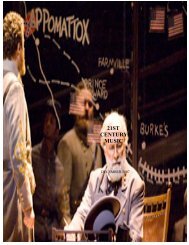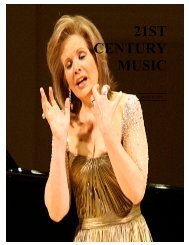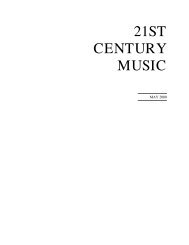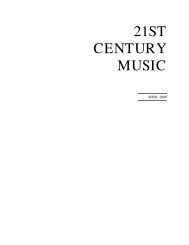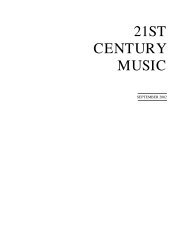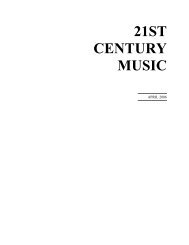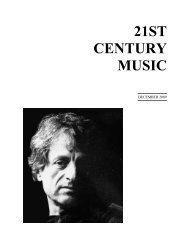You also want an ePaper? Increase the reach of your titles
YUMPU automatically turns print PDFs into web optimized ePapers that Google loves.
From the scholarly perspective, the most valuable essay here<br />
is John Schott’s appreciation of complexity in John Coltrane,<br />
After acknowledging the jazzman’s intensive study of Nicolas<br />
Slonimsky’s Thesaurus of <strong>Music</strong>al Scales and Patterns, Schott<br />
reprints an extraordinary chart purportedly drawn by Coltrane<br />
in 1960 and given to Yusef Lateef, who later reprinted it.<br />
In Schott’s interpretation, "The diagram juxtaposes the two<br />
whole-tone collections five times around the perimeters of a<br />
circle. Lines are drawn connecting each tone to its tritone<br />
across the circle, bisecting the circle 30 times. Every fifth tone<br />
is enclosed is a box to show the circle of fifths. Each member<br />
of the circle of fifths is also enclosed with its upper and lower<br />
neighbors in two ovals," etc. While acknowledging the<br />
metaphysical implications of the diagram’s configuration,<br />
Schott’s theme is that Coltrane wanted to realize within an<br />
improvisatory context the intensity of overlapping<br />
interconnections typical of serial composition.<br />
As always with anthologies of living artists, a skeptical reader<br />
wonders why some people were not included here. I can think<br />
of several others similarly situated whose thoughts I would<br />
like to read. Since Zorn as a performing musician and record<br />
producer not known for catholic enthusiasm, I could imagine a<br />
sequel with a different group of composers, likewise middleaged,<br />
not to mention a third anthology from those a generation<br />
younger.<br />
Arcana also benefits from thoughtful design. For one index,<br />
consider that footnotes are put not at the end of the book or at<br />
the bottom of the book’s page, as is customary, but directly<br />
adjacent to the reference, in indented white-space. Instead of<br />
looking to the bottom of the page or, worse, flipping to the<br />
back of the book, the reader wanting a reference merely<br />
follows his or her eyes across the page. Why is it that this<br />
design innovation for academic crediting should appear in a<br />
book published not by a university press but an art-book<br />
dealer<br />
In several ways, Arcana is richly thoughtful and mostly<br />
readable.<br />
37



